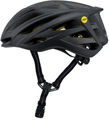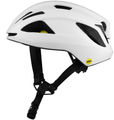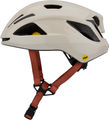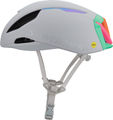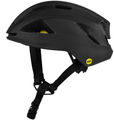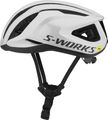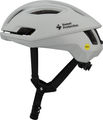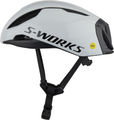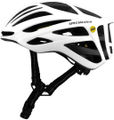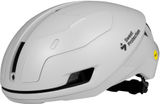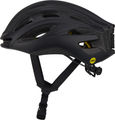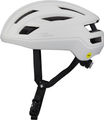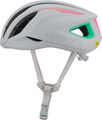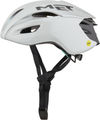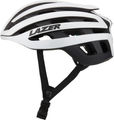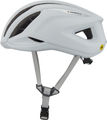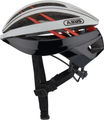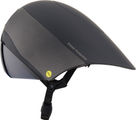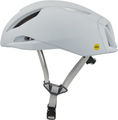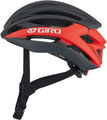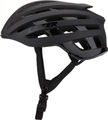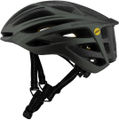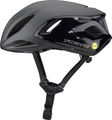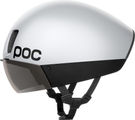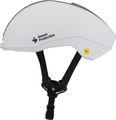Road Helmets • Helmets
OUR Road Helmets • Helmets RECOMMANDATIONS
New Arrivals
Our Suggestions
Do you need a new road bike helmet, but want to learn more about modern models first? Our guide will help lead you to the right helmet.
What material is a road bike helmet made of?
The long brown leather bulges of old-fashioned helmets have long been passé for good reason. These days, road bike helmets consist of an outer shell made of particularly light and robust (poly-)carbon. EPS (expanded polystyrene) makes up the inner portion of the shell, which is also very lightweight and can absorb a lot of energy. This inner layer is either glued to the outer shell or both components are welded together using the In-Mold process for a complete and very secure bond. This process lends the helmet even more stability in the event of a fall.
Safety: From helmet standards to MIPS
In order to be allowed to put a bicycle helmet on the market at all, it must at the very least adhere to Euro standard (EN) 1078 or 1080. To meet this, helmet manufacturers test helmets by means of fall simulations from certain heights and onto different surfaces. If a helmet protects the head according to the standards set forth, it earns the CE mark. For Europe, all other standards outside of the CE mark are supplemental, not substitutes. What’s more, helmet manufacturers have come up with various designs and technologies in order to provide optimal protection for the cyclist's head beyond what's normally required. One system that has won over many bikers in recent years is the Swedish-developed MIPS system. The abbreviation stands for "Multi-directional Impact Protection System." In this manufacturing process, helmets receive an additional low-friction layer that floats between the outer shell and the padding. It can shift in the helmet shell upon impact, absorbing the rotational forces that occur during a fall and directing them away from the brain, thereby reducing concussions and/or brain damage. These days, many well-known manufacturers such as Giro, Bell and Specialized, use MIPS technology in some of their models.
Lightweight, lighter, road bike helmet
In addition to the all-important safety aspect, having the lowest possible weight is a huge factor for road cyclists when selecting a helmet. "Light" in this case usually means up to or around 300 grams. The longer you are on the road, the more comfort a lightweight road bike helmet provides. Your head has more freedom of movement, and no extra weight weighs down on your neck, which is already strained by sitting in an athletic position. Best-case scenario, you’ll hardly notice that you are wearing a helmet at all, and you won’t be tempted to leave it at home for the sake of convenience. Unlike mountain bike helmets, road bike helmets are less bulky, significantly lighter, and do not encase the back of the head or temples. The reason for this is due to the more angular seat position adopted by road cyclists, which requires more freedom for the neck to move around. The focus of protection for road bike helmets falls on forehead and towards the front of the head.
In addition to low weight, good ventilation
on road bike helmets also contributes to a rider developing their optimal performance, and ensures that one does not come back from touring with a sweaty head or that they will forego a helmet in hot weather. The slots on the helmet are there to provide ventilation, and additional "wind tunnels" inside the helmet channel that fresh air around the head. Altogether this ensures that you can keep a cool head even when you’re hot and exhausted. The number of vents ranges from 15 on average to models that have 30 or more for optimal thermal cooling. Helmet padding also contributes to comfort: it wicks away moisture to the outside, dries particularly quickly and inhibits the formation of odours. However, it's not just the number of vents that makes a difference – some manufacturers design their ventilation systems so cleverly that they use a few strategically-positioned air ducts to stream air around the entire head without perforating the helmet surface. That certainly has some aerodynamic advantages.
Aerodynamics – The shape of a road bike helmet
Aerodynamics play a huge role in road cycling. At speeds from about 15 to 20 km/h, air presents the greatest amount of resistance – and, unlike rolling resistance or friction loss on the drivetrain, it increases exponentially with speed. That's why road helmets typically drop down sharply at the back: to reduce air turbulence. Some manufacturers offer a special cover that can be pulled over the helmetand improves aerodynamics by closing off ventilation openings. Others have developed a design that reduces wind resistance regardless of head tilt.
Even more aerodynamics – The time trial helmet
If you are a triathlete or take part in time trial races, aerodynamics are a major focus – apart from the right road bike and an aerodynamic riding position, specially-shaped helmets are key: they are extremely light, taper off at the neck and deflect the wind backwards at the rear. Extra large vents provide cool airflow to the head and a full visor also offers better aerodynamics than a normal road bike glasses.
Visors and glasses for road helmets
The plus in aerodynamics as well as the protection against wind and insects thanks to the visor is also used by some manufacturers for models that are not designated as time trial helmets. For example, some road bike helmets have a removable magnetic visor. Other manufacturers equip their helmets with a holder for glasses– usually a rubberised insert in the outer vents that holds glasses firmly in place when not in use.
Road bike helmets for men, women and people with ponytails
Road bike helmets are almost always designed as unisex models and only differ in size, since the head circumference, i.e. the right fit, is what matters when choosing the right helmet. The smallest sizes usually start from a 48 centimetre head circumference and are then of course also particularly light at about 220 grams. Some helmets are explicitly designed as "women's models", and are available starting at a small head circumference, but are otherwise singled out because of a design that is meant to appeal to women. Many manufacturers also indicate if their helmets are ponytail compatible, which means that the helmet is suited especially for ponytail or plait wearers due to its construction at the back of the head. These include, for example, helmets from Abus or Lazer.
Which helmet to wear for gravel biking?
If you like to ride your gravel bike on tours, you attach less importance to speed and are often away from paved roads, and ride more often on forest and field paths. This means that you can rather forego the aerodynamics factor when choosing a helmet. Ideal helmets in this case are lightweight, offer good all-round protection and at the same time are comfortable to wear. Basically, you can use any road or mountainmountain bike helmet for gravel rides. For MTB helmets, it is important that the visor does not restrict your field of vision. The most important thing is that the helmet allows you optimal freedom of movement and has the right.
